Jodrell Bank's role in early space tracking activities - Part 1
An article by Sven Grahn - "Spaceflight History, Space Radio Tracking and Space Technology" web site.
A strange new world
During the first years of the space age the public was exposed to a strange new world. Journalists and scientists scrambled to explain it and interpret technology and events. A source of facts about and authoritative comment to ongoing space missions was the Nuffield Radio Astronomy Laboratories, Jodrell Bank, Cheshire (called Jodrell Bank hereinafter) and its director, professor (later Sir) Bernard Lovell. The observatory could intercept signals from space vehicles, interpret their general meaning as to progress of this particular space mission and thereby provide an independent source of news. Especially, official news about Soviet space events was not always completely candid.
These circumstances have given Jodrell Bank a unique place in the history of the early space age. I have long been fascinated by this aspect of space history and wanted to explore not only why and how Jodrell Bank was drawn into this role, but also the details of its space tracking activities. These were great events of my youth and I am still curious as to what really happened!
The public record contains a lot of this information, but to reach deeper I decided to contact the observatory and ask for permission to study its archives. Professor Lovell himself graciously wrote to me to give several useful references in the the literature and to direct me to the Jodrell Bank Archives kept in the John Rylands Library of the University of Manchester. I finally found the time and opportunity to travel to Manchester and on 6 April 1998 I spent a full day in the gothic-style reading room of the John Rylands Library. It was fascinating to read about space events some forty years ago in a room where beautifully illuminated medieval manuscripts are on display.
The present essay is the result of this visit and of an exploration of my own archives. As with other material at this Web site the perspective is that of my own personal fascination with the use of radio monitoring signals from space vehicles as a means of determining the true nature of their missions.
The creation of the telescope and the observatory
Bernard Lovell was born in 1913. He studied physics at the University of Manchester under professor Patrick Blackett, was called up for wartime work on centimetric radar and learned about the potential of radar to detect not only enemy aeroplanes and vessels but also natural phenomena in the earth's vicinity. After the war Bernard Lovell returned to the University of Manchester and started scientific work with ex-army radars in the Cheshire countryside at the now famous place known as Jodrell Bank. The original idea was to use radar to study the secondary effects of cosmic rays in the earth's atmosphere, but the work shifted in the direction of studying ionized meteor trails and later to use radar to study the moon and the planets (radar astronomy). Later, of course, active radar studies were supplemented by what we now know as radio astronomy, that is using a radio receiving system to investigate processes in the universe.
This trend started with the construction in 1946-47 at Jodrell Bank of a 218-foot zenith-pointing, wire-grid, fixed paraboloid. This was intended to achieve the goal of detecting cosmic ray "echoes" but proved to be a powerful tool for mapping cosmic radio noise and discrete sources (notably the discovery in 1950 of the first extragalactic radio source, the M31 spiral nebula in Andromeda). The receiving beam of this telescope could be moved by moving the feed from side to side, but this only provided minor beam steering. The desire to provide a fully steerable instrument must have been irresistible in view of the string of discoveries in radio astronomy in that period. Lovell and Blackett discussed the possibility of a fully steerable telescope during the winter of 1948-49. Work on preliminary ideas for a 250-foot steerable parabolic dish started in various forms in the 1949-1950 period. The initial go-ahead from funding agencies to proceed with the preliminary design phase of the project was given on 22 June 1950.
The telescope design was entrusted to the engineering firm Husband & Co and final approval of the funding of the project was given by the DSIR (Department for Scientific and Industrial Research) in March 1952. The concrete foundations of what was to be known as the Mark I telescope were finished in May 1953. The circular tracks that make it possible for the telescope to move in azimuth were laid in March 1954. Problems in developing the electric drive motor system for the telescope caused considerable delays and after a change of contractor the system was finally delivered in the spring of 1957!
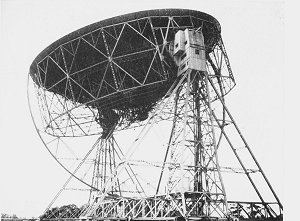
The Mark I antenna
How Jodrell Bank was drawn into space tracking
The Mark I telescope was first controlled by computer (in azimuth) on 1 October 1957, but technical and financial troubles still plagued the telescope project. However, the dawn of the space age was just a few days away and the launch of Sputnik would give a new role to Jodrell Bank. The telescope was not used to listen to the bleeps of Sputnik on 20 and 40 MHz, because this could be done with very simple equipment, but rather to detect the presence of the carrier rocket of Sputnik 1 with the radar equipment used for obtaining echoes from meteors which was hurriedly moved to the big Mark I 250 ft dish. The enormous gain of the big dish coupled with the 150 kW transmitters on 120 and 36 MHz conclusively detected the Sputnik rocket on Saturday, 12 October 1957. Later, when Sputnik 2 was launched, Jodrell Bank again observed the carrier rocket (with the attached dog cabin) by radar.
Even though the telescope brought credit to Britain, sponsors were not flocking to solve the financial difficulties of the telescope project. But the immense size and capability of the telescope was recognized as an invaluable asset when the United States decided to initiate a crash program to send a probe to the Moon - the Able I project. The U.S. ground tracking installation for this and other projects in the Able series were clearly inadequate - the Able project and the US Army space probe (Pioneers III and IV) definitely needed Jodrell Bank. The USAF and its contractor STL, Space Technology Laboratories (a subsidiary of the Ramo-Wooldridge Corporation, later TRW) put trailers with equipment at Jodrell Bank and paid to use the telescope. Also, the exploits of the telescope in tracking US and Soviet space probes led, perhaps indirectly, to a donation from Lord Nuffield to pay off the telescope's remaining debt. The Nuffield Foundation had been part of the funding scheme for telescope from the outset (together with public funding from the DSIR) and now helped complete the construction effort.
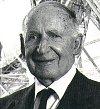
Sir Bernard Lovell
As Sir Bernard Lovell explains in one of his books (1) there were arguments among the scientific staff as to the advisability of going after the space probes - taking away valuable observation time from radio astronomy. But, clearly, the first space probes explored regions of space where Jodrell Bank had a scientific interest; the Moon and the near-earth planets. Remember, these were exciting times and being part of this process of discovery must have been irresistible to Sir Bernard, the director of the observatory. Also, it put Jodrell Bank into the media focus as a main player in the early space age and as an authority on current events in space. Indirectly and directly it seems that the space tracking activities attracted funds to the telescope - money that could be put to good scientific use in the radio astronomy work.
While the early warning radars at Fylingdales Moor were being constructed Jodrell Bank was held in a sort of readiness to track Soviet ICBM:s by using the big antenna as a radar. The radar tracking of the Sputnik rocket bodies (and later Sputnik 3 itself) demonstrated that the telescope had the capability to detect missiles at great range and the telescope was given an interim ballistic missile early warning role. Presumably also this effort provided some much needed funding for the telescope.
Later, in the early 60's, there was not only the need to support US space probes, but also to help monitor the USSR space probes from an intelligence-gathering point of view. In the mid-60's the United States set up a "Deep-Space Collection" programme with stations at several points around the globe, including Jodrell Bank. Whether or not this brought a large financial advantage to Jodrell Bank is not known, but it probably did not work to its disadvantage.
In a sense, the USSR also used the capabilities of Jodrell Bank. In many circles the first Soviet lunar probe, Luna 1, launched on 2 January 1959, was simply not believed to have existed (See (8)). This must have annoyed the Soviet authorities enormously, despite the fact that the transmission frequencies were announced directly after launch. For their second successful launch they decided to try to engage Jodrell Bank as a source of independent verification of any claim of success. Therefore the USSR sent detailed instructions to Jodrell Bank how to find their second lunar probe, Luna 2, that was launched on 12 September 1959 and hit the moon the next day. Jodrell Bank provided scientific proof that Luna 2 actually reached the moon, and the USSR continued to provide pointing and frequency data to Jodrell Bank for a number of years.
Probably the Soviet Union felt uneasy about asking for such help after the US "Deep-Space Collection" programme was underway and Jodrell bank became part of this intelligence network. Despite any such possible misgivings, it seems that Jodrell bank was asked to monitor the Venera-4 landing (4) on Venus in October 1967. The reason for the Soviet interest was probably also that their own ground station network was not very capable in those early days and they wanted some back-up capability in case of a crisis. In effect, this also happened, when the Soviet ground stations lost contact with Venera-1 five days after launch and asked Jodrell Bank to try to detect signals from the probe when it passed near Venus three months later - but, alas, to no avail.
Space tracking exploits by Jodrell Bank
Nowadays, Jodrell Bank devotes its time entirely to radio astronomy. But the glory days of space tracking represent a story worth telling. This text is a modest attempt to recount this tale.
The Able program
At the end of 1957 and early months of 1958 many persons and organizations in the U.S.A. were jockeying for positions to get the task of answering the "Sputnik challenge". The pressure from politicians in the U.S. executive branch and in Congress on those responsible for missiles and space development to quickly come up with significant space exploits was intense. The Air Force Ballistic Missile Division in Los Angeles (with the Space Technology Laboratories as their engineering organization) under Brigadier General Bernard Schriever was one organization that thought it had the necessary know-how and clout to do the job. The same was true for the U.S. Army Ballistic Missile Agency under General Medaris and with Wernher von Braun in charge of its engineering organisation in Huntsville, Alabama.
Thus, the White House announced on 27 March 1958 that it had approved a program "to determine our capability of exploring space in the vicinity of the moon and to obtain useful data concerning the moon". The program was announced by Defense Secretary Neil H McElroy. The Air Force Ballistic Missile Division in Los Angeles was assigned a program of three lunar probes using a "Thor-Vanguard" system with "a third stage to be developed". The Army Ballistic Missile Agency in Huntsville, Alabama was authorized to "undertake one and possibly two lunar probes" using modified Jupiter-C rockets. Overall responsibility for the lunar probe launches was assigned to the Defense Department's Advanced Research Projects Agency (ARPA).
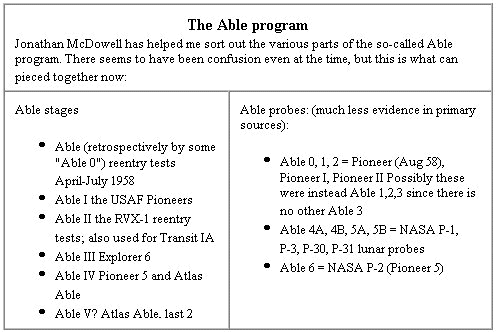
The Air Force project had its roots in the "Able project" which was probably designed to provide a rocket that could test re-entry vehicle (RV) technology for the ICBM that had not yet been flown successfully. To achieve the speeds necessary to test a reasonably sized RV the USAF and its contractor the Space Technology Labs used a Thor IRBM with the second stage of the Vanguard as the upper stage. This combination was test flown three times in 1958, the first time less than a month after the White House announcement and the last less than a month before the first lunar probe attempt. (Launch dates for the Thor-Able 0 rocket are: 23 April, 9 July and 23 July 1958).
Obviously support from Jodrell Bank to the Able project was requested through various channels during the spring of 1958. The correspondence from the Able project office during this period contains details of the lunar probe. In a letter to Jodrell Bank from the AFBMD dated 6 May 1958 the radio systems of the probe are described: The telemetry transmitter would operate on 108.03 MHz at 1 watt with phase modulation (modulation index < 0.5 radians). There would be sub-carriers transmitted on the main phase-modulated signal. These subcarriers contained data on the magnetic field, the temperature of the retrorocket propellant, the deceleration of the probe (presumably to monitor the functioning of the retrorocket) and a meteorite microphone. The antenna for 108.03 MHz would be a "loop antenna" coated on the outside of the cylindrical portion of the space probe which would spin at 2-3 Hz. The Able-1 television system would use the same frequency (108.03 MHz) but with AM and a much higher transmitter power. The battery powering this transmitter would last only a few hours. The TV transmitter would be switched on by a timer 65 hours after launch.
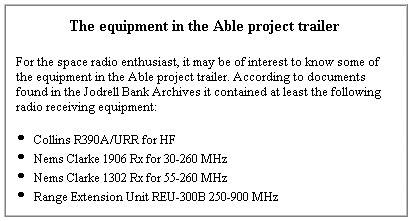
The extreme haste with which the early lunar probe attempts were organized is evident from the correspondence. For example, a letter from George Mueller at STL dated as late as 19 May 1958 asked for the precise co-ordinates of the radio telescope at Jodrell Bank. (In the reply the co-ordinates were given as 53 degrees 14 minutes and 11 seconds north and 2 degrees 18 minutes and 22 seconds west.). Newspaper reports from Britain on 25 July 1958 talked about trailers marked "Jodrell Bank, U.S. Air Force, Project Able" arriving at Jodrell Bank in preparation for the lunar probe attempts. Professor Lovell declined to give any further comment to the press saying only that the US equipment would be used in conjunction with the observatory's own systems for joint work on "various satellite projects".
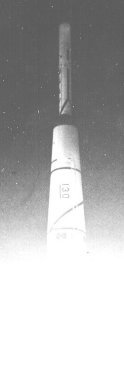
So, the use of Jodrell Bank for the Able project leaked out and the observatory was, for the first but not last time, engulfed in a media frenzy. The correspondence files reveal much about the efforts to handle the media and the public and their insatiable need for information. For example, the Jodrell Bank records contain a memo written by Lt. Col. W G Hingston entitled "Jodrell Bank Telescope. Record of events prior to launching of Lunar Probe." The memo deals with publicity aspects of Jodrell Bank's support for the project and how to control the flow of information. In an entry dated 8 August 1958 the memo says "Nothing was to be said by Jodrell Bank until the rocket had been launched". The DSIR also sent a list of frequently asked questions about Jodrell Bank's support of the Able project and professor Lovell filled in the answers. This was intended to make it easier to handle the flood of press inquires.
Not only the public, but also colleagues in the radio astronomy field approached Sir Bernard to obtain information about how to track the Able probes. However, Jodrell Bank lived under the publicity rules set out by the US authorities. For example, a telegram from O Rydbeck, head of the Onsala Space Observatory outside Gothenburg in Sweden, was received on 5 November 1958 requesting information concerning the launch time, sidereal co-ordinates, frequency and modulation for the upcoming lunar probe. In the reply Prof. Lovell writes that he is "unable to answer without permission of US authorities" and asks Prof. Rydbeck to contact ARPA in Washington DC. This strict policy of not giving away details about frequencies of the received signals is evident from the correspondence. All letters from radio amateurs or other individuals asking for frequency information that I found in the files are marked no reply.
Signals from Explorer 4 were used (it transmitted on 107.997 and 108.03 MHz, practically the same frequencies at the Able lunar probe) to test the receiving equipment at Jodrell Bank to be used for the Able project. Well, the first moon probe attempt failed 77 seconds after launch on 17 August 1958 because of a failure of the turbo pump gearbox of the Thor first stage. On 11 October 1958 what came to be called the Pioneer 1 space probe was launched from Cape Canaveral (right) at 0842 UT. Jodrell Bank picked up telemetry from the probe ten minutes after launch. This probe did not reach the moon, but provided valuable data on the radiation belts of the earth. The third and last launch in this initial series of lunar probes in the Able project failed after launch at 0731 UT on 8 November 1958.
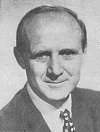
The U.S. Army/JPL lunar probes
The U.S. lunar probe baton now passed to the U.S Army. The army team again had the Caltech Jet Propulsion Laboratory (probe and ground system design) and professor James van Allen (radiation sensors) as members. This was the same team that built, launched and tracked the first U.S. satellite, Explorer 1. The probe was extremely small and had a telemetry system similar to that of the Able probes, but it operated on 960.05 MHz (instead of 108 MHz), a frequency later used for the Ranger series of lunar probes and for the first successful Venus probe, Mariner 2. Again, support from Jodrell Bank was needed. Preliminary contacts must have been taken with Jodrell Bank earlier during 1958 so that the necessary receiving equipment would be assembled, but the formal request for tracking support was made in a telegram from William Pickering, the director of JPL (see picture on the right) as late as on 19 November 1958! This was only 17 days before the launch of Pioneer 3, which took place from Cape Canaveral at 0545 UT on 6 December 1958 by a Juno 2 rocket.
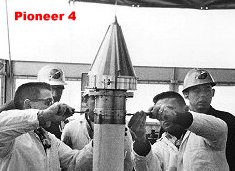
Jodrell Bank picked up the Pioneer 3 probe that only reached one-third of the way to the moon. The disappointment over this failure was considerable and Wernher von Braun noted in interviews that a thorough shakedown of the systems of the Juno 2 was necessary before another attempt at the moon could be made. Therefore the next launch opportunity, which occurred on 2 January 1959, could not be used. As we shall see, the Soviet Union grabbed this opportunity!
After the Pioneer 3 launch U.S. space officials from STL visited Jodrell Bank on 10-11 December 1958 to outline co-operative efforts in space tracking during 1959. The memo setting out the details of the meeting is marked CONFIDENTIAL. The projects that were foreseen to need tracking support from Jodrell Bank during 1959 were "Army probe, February 1959: as in December 1958" and "USAF earth satellite (last 2 weeks in April 1959): Command: 401 Mc Telemetry: 378 and 108 Mc" as well as "USAF Deep space probes (early June 1959): Command: 401 Mc Telemetry: 378 Mc"
The U.S. Army Pioneer 4 probe was not launched until 0511 UT on 3 March 1959 and Jodrell bank picked it up 13 minutes after launch. Professor Lovell revealed to the media that it was "off course" already two hours after launch. It flew past the moon at 59200 km distance.
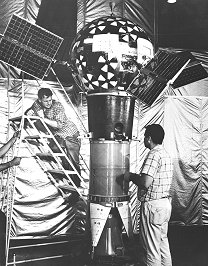
Supporting the Able project again
The next major support task to the U.S. space programme by Jodrell Bank was supposed to have been tracking the lunar orbiters (see picture on the right) launched by Atlas-Able rockets. On 24 September 1959 the booster for the first of these probes exploded at Cape Canaveral during a ground test. So, hopes of getting a lunar shot off on 3 October were therefore dashed. Instead, the Soviet Union launched Luna 3 around the moon on 4 October (see below). On 26 November 1959 the Pioneer P-1 probe was launched by an Atlas-Able from Cape Canaveral at 0726 UT, but the nose shroud was ripped from the vehicle and it went down in flames. This occurred at 70 seconds into the flight when second stage telemetry ceased. The mass of the lunar probe was 169 kg, and it seems to have contained a scanner camera for taking farside pictures.
The only really successful space probe in the Able project was Pioneer 5 which was launched by a Thor-Able rocket from Cape Canaveral into a solar orbit on 11 March 1960. This 43 kg space probe was originally conceived as a Venus probe, but after all the difficulties with the Able lunar probes the scope of the Pioneer 5 mission was scaled down to an interplanetary cruise. Jodrell Bank sent the command (on 401.85 MHz) that separated the probe from the last rocket stage when it was 8000 km from earth, In early April 1960 the command station in Hawaii had difficulties reaching the probe and Jodrell Bank started playing a bigger role in commanding the probe. The probe's 150 Watt transmitter on 378.21 MHz was last heard by Jodrell Bank on 26 June 1960 at a distance of 36.2 million kilometres!
A letter from W. M. Duke at STL dated 2 March 1960 found in the Jodrell Bank Archives requested the support of Jodrell Bank for the Able-5 project, the last two Atlas-Able attempts to reach the moon. STL wanted Jodrell Bank to receive 64 bps telemetry, while STL stated that its own RANTEC helix antenna (installed at J.B.) could handle the 8 bps telemetry. In April NASA announced the launch dates for these probes as 25 August and 14 November 1960. The probes were launched a month later than planned. On 25 September 1960 the launch (at 1513 UT) of the Pioneer P-30 probe failed when the second stage of the Atlas-Able did not ignite. The Pioneer P-31 probe was lost on 15 December 1960 when the Atlas-Able rocket explodes shortly after launch at 0840 UT and the Able program ended after almost three years!
The early Soviet Luna probes
Luna 1 - whizzing past the moon - did anyone hear it?
Luna 1 was launched from Baikonur at 1641:25 UT on 2 January 1959 and was intended to hit the moon, but missed its target by 6400 km because of "a human error in calibrating a direction finder" (12). A telegram dated 8 May, 1959 from Professor Lovell was sent to the Committee on Science and Astronautics of the U.S. House of Representatives and its Special Subcommittee on Lunik Probe set up to investigate the claim by author Lloyd Mallan in his Book "The Big Red Lie" (8) that the first Soviet lunar probe was a hoax: "We did not succeed in detecting any signals from Lunik. Search was made with the large telescope over a frequency band covering 183.6 megacycles which was the stated tracking frequency during the night of January 3 to 4 when Lunik was said to be close to the moon. No tracking errors could account for failure because telescope beam was adequate to cover position of probe at time of close approach. Telescope was in similar operational condition which has enabled us to track Pioneer 400,000 miles. We conclude that Lunik was not transmitting continuously at least on this frequency during that night. Emphasize that we do not disbelieve in existence of lunar....." (6). It is interesting to find copies of pages from Lloyd Mallan's book "The Big Red Lie" in the Jodrell Bank Archives that are stamped UNCLASSIFIED!
Luna 2 - the first spacecraft to reach another celestial body
On Saturday, 12 September, 1959 at 0639:26 UT (other sources say 0639:42) the space probe to be known to history as Luna 2 was launched from Baikonur by the three-stage 8K72 rocket based on Sergei Korolev's ICBM R-7. At 1400 UT the very same day the following telex was received at Jodrell Bank (RED text is the RCA operator):
"JODRELL BANK. THIS IS NASA WASH DC DO YOU HAVE ANY INFORMATION RELATIVE TO USSR LUNAR PROBE REPORTEDLY LAUNCHED THIS MORNING? THIS IS THE RCA TEX OPR. SIR APPARENTLY YR SUB IS UNATTENDED. IT IS TWO PM OVER THERE, SHOULDN'T SOMEONE BE THERE? CANNOT ANSWER THAT SIR. BEING A SATURDAY, THEY MIGHT BE OFF. ALL RIGHT FORGOT ABOUT IT BEING SATURDAY. WILL SIGN OFF THANKS."
In (1) and (58) Sir Bernard describes that when Moscow announced the launching of Luna 2 he was playing cricket (he was the skipper of the village team in neighbouring Chelford). Before the cricket match he had stopped by the Project Able trailers at the observatory and chatted with the U.S. crew. After having had an early lunch he headed for the cricket ground at 1230 UT to be in time for the match due to start at 1330 UT. Just after leaving his home a child signalled him to stop his car and told him "You must come back, you're urgently wanted on the phone". The duty controller at Jodrell Bank informed Sir Bernard that the Russians 'had launched a rocket which would reach the moon on Sunday evening'. A reporter phoned and asked what Jodrell Bank 'was going to do about it'? To which Sir Bernard replied 'I am going to play cricket'. Having been unable to track Luna 1 and receiving very little help from the Russians in locating that probe he was not so keen on wasting the observatory's time on another moon probe. The cricket match took a tea break at 1550 UT. Sir Bernhard then phoned his colleague John Davies and agreed to meet at the observatory at 1830 UT. Sir Bernhard was still in a casual frame of mind and not particularly keen on going after Luna 2 until he unlocked the office with the telex machine. In Sir Bernards own words (58):"And there, with the paper streaming out on the floor, was a message from Moscow giving precise details details of the frequencies of the transmitters in the Lunik and the co-ordinates for the latitude and longitude of Jodrell bank giving the time of lunar impact as 10 p.m. the following evening".
I found the antenna pointing data for September 12, 1959 in the Jodrell Bank Archives in the original teletype printout of a telegram timed at 1746 Moscow Time (1446 UT), some eleven hours after launch. The initial line of the telegram starts ETAT URSS GOVT.... .This is French and could mean it was a "telegram of state". Someone has written "19.992" with a pen on the telegram sheet. This of course refers to one of the frequencies used by Luna 2. So, at the time the telex inquiry from NASA came through the telegram from Moscow with the frequency and pointing data had not yet arrived.
In contrast to its failure to pick up Luna 1 earlier that year Jodrell Bank now promptly picked up signals. It may be interesting to examine the technical details of the receiving system. The antenna feed for 183.6 MHz was a folded wire dipole with a reflector and on 20 MHz a folded wire dipole without reflector was used. The bandwidth used to receive signals on 183.6 MHz was 5 kHz and on 750 Hz on 20 MHz (10). Signals were recorded on tape and sent to the Russians. The tape recording of the signals on 19.992 MHz from Luna 2 were made with the tape recorder connected directly to the radio receiver, while the signals on 183.6 MHz were recorded via a microphone (11). This is the reason for hearing voice announcements and timing information on the tapes with signals from Luna 2 on 183.6 MHz. Also, the local oscillator of the 183.6 MHz receiver was not under crystal control and the pitch variations heard on the tape sent to Moscow therefore were due to receiver drift.
On 13 September 1959, Moscow again sent pointing data for Jodrell Bank. The data series starts at 1700 UT, the time when the probe would rise above Jodrell's horizon and ends at 2100 UT, the expected time of hitting the moon!:
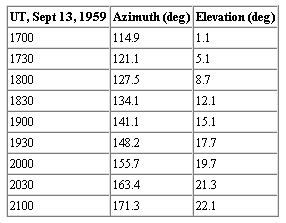
The announcement by professor Lovell that the signals from Luna 2 had ceased at 2102:23 UT on 13 September 1959 was the first confirmation the world received that an object made by humans had travelled from the earth to another heavenly body! I can remember how Radio Sweden broadcast a special "vigil" between 2000 and 2130 UT while waiting for confirmation of the impact on the moon. I listened to this broadcast live and I can clearly recall the feeling of participating in a historic event when the telegram about loss-of-signal at Jodrell Bank was read shortly after 2111 UT!. I was 13 years old - I will never forget it!
It is fascinating to see in the Jodrell Bank Archives how the doubters still thought the Russians were making it all up. A message to Lloyd Mallan (the author of the "Big Red Lie" (8)) dated 15 September 1959 reads: POSITION OF ROCKET SIGNALS DID NOT AGREE WITH THAT OF MOON UNTIL END OF PERIOD. DOPPLER RECORD PROVES THAT ROCKET DID HIT THE MOON. J.G. DAVIES, JODRELL BANK.
Maybe it was in a desire to help dispel all the doubts about the Soviet feat or due to just plain courtesy that Jodrell Bank dispatched the Doppler frequency measurements made on the 19.992 MHz signals during the final phase of approach to the moon to Moscow on 17 September 1959. Tape recording of the signals were sent to Moscow on 9 December 1959 (11).
Luna 3 - the first view of the moon's far side
In the small hours of 4 October 1959, a mere two years after the launch of Sputnik, the Soviet Union launched its most impressive space spectacular ever - Luna 3 - the first space vehicle to catch a view of the moon's hidden far side. The E-2A probe weighing 278.5 kg lifted off at 0043:39 UT on an 8K72 rocket from Baikonur. The space probe was placed in an earth orbit with perigee at 48280 km, apogee at 468300 km and an inclination to the equator of 55 degrees (13). During its flight, that lasted until 29 April 1960 when it decayed in the earth's atmosphere, Luna 3 was to bring credit to its creators and put Jodrell Bank again into the media focus.
Soviet media announced that Luna 3 transmitted signals on 39.986 MHz that consisted of pulses 0.2-0.8 seconds long sent at a repetition rate of 1 +/- 0.15 Hz. The transmitter on 183.6 MHz was also used for tracking (trajectory determination). Information from the probe was sent at intervals of 2-4 hours/day. On 4 October 1959 the transmitters were to be switched on at 1300 MT (1000 UT) to operate for two hours (until 1200 UT) at a point 108000 km over 80 degrees east and 5 degrees south.
For Luna 3, the Soviet Union again provided Jodrell Bank with pointing information for its telescope during the Luna 3 flight. Such data were sent on 4,7,8,9 October 1959 and on several more days in October 1959. Therefore, Jodrell Bank successfully picked up Luna 3 less than ten hours after launch: Signals on 183.600 MHz were received at 1206-1220.25 UT on 4 October 1959 (this agrees reasonably well with the schedule announced by the Russians at launch - see above). Jodrell Bank kept their colleagues at NASA up to date with its tracking activities on a daily basis. Pointing information from the Russians were obviously also relayed to NASA (16). In general, observations were sent both to the USA and the USSR. All data from the USSR were forwarded to the U.S., but not vice versa. As we shall see later, comprehensive reports including tape recordings were sent to Moscow after the flight was over. The reports to NASA were sent to the telegram address SPACE CONN NASA WASH DC (for the attention of an individual called Bryant) and in a message dated 5 October 1959, observations made on 5 October 1959 were described: Signals received on 39.986 MHz from 1035 to 1412 UT. At 1301 UT the frequency is fluctuating rapidly and at 1351 UT the frequency starts drifting down rapidly. Does this observation support a report (12)"that communications with the vehicle were intermittent at best and there was concern that no photographs would be received"? Telemetry also indicated a serious overheating which threatened the mission but was overcome by sending ground commands (12).
The closest approach to the moon occurred at 1416 UT on 6 October 1959 when Luna 3 passed over the lunar south pole at a distance 7884 km from the moon's centre.
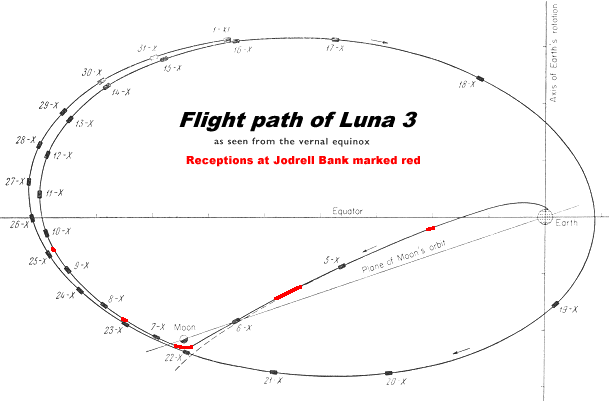
Jodrell Bank observed Luna 3 again on 6 October 1959 (29): "Signals received Oct 6 183.6 Mc/s only. 1342-1405.40 UT:15 sec on 15 sec off (probably the off period represents a frequency shift). 1405.40-1409.30 UT: No signals in band. 1409.30-1510 UT: usual bleeps. 1510-1538 UT: Modulation as in first period." There were two signals in the band with about 5 kHz separation (29). Was the silence at 1405.40-1409.30 UT caused by the probe's passing behind the edge of the moon?
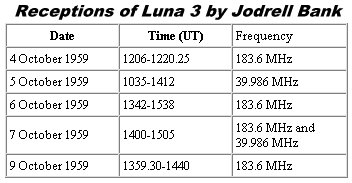
The 29 exposures of the moon's far side were taken at 0330-0410 UT on 7 October 1959 when the probe was 65567-68785 km from the moon's centre (15). The film was then developed, fixed and dried on board. Thereafter it could be scanned with a light beam with up to 1000 lines per image for transmission to earth. Radio observations on 7 October 1959 were described as (30): "Signals on 183.6 Mc/s 1400-1459 UT. 39.986 MHz for about 3 minutes before 1505 UT. The probe appeared to be 1-1.5 degrees above the elevation given by the Russians. CW at one of several frequencies near 183.6 MHz between 1400 and 1412. Bleeps from 1412 to end. Bleeps on 39.986 MHz. The two frequencies were not on together." This description of the signal does not seem to indicate that a picture transmission similar to facsimile was being made. Jodrell Bank made no observations of Luna 3 on 8 October (16) , but on 9 October signals were again received (see table for details).
On Monday 19 October 1959 newspapers (17) reported that Moscow media circles had started to talk about the fact that pictures had been taken of the moon. These reports appeared after the probe had come close enough to the earth to provide sufficient picture quality. Had the transmission of pictures failed the rumours would never had started, it was speculated (17). The pictures of the moon's far side were distributed by tele-photo from Moscow late on Monday (UT) 26 October 1959 and created another space-age media frenzy. According to newspaper reports at the time the picture transmission to earth took place on 18 October 1959 (18).
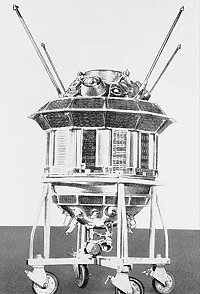
Jodrell Bank kept up contacts with the Russians even after their publication of the far side pictures. On 1 November 1959 a telegram was sent to AN USSR asking for "co-ordinates for the next transmission from Luna 3", and the first batch of tapes of signals from Luna 2 and 3 were sent to Prof. Nesmeyanov of AN USSR on 9 December 1959. In the accompanying letter Prof. Lovell thanked the Academy for the data with pointing information for the Jodrell Bank telescope. The final batch of Luna 3 tapes were sent to Akademi Nauk on 14 January 1960.
The story about Jodrell Bank's reception of Luna 3 signals could have ended here, but there is an interesting epilogue: On 17 January 1961 the director of the Jet Propulsion Laboratory, William Pickering, wrote to find out if Jodrell Bank had recorded pictures from Luna 3 and if JPL could have copies of the tapes. Prof. Lovell replied on 20 January 1961 by saying that "Yes, we have a considerable number of tape recordings", and that he had asked Dr. J.H. Thomson to find the tapes, copy them and send them to JPL. Probably the CIA analysed the tapes sent to Dr Pickering, because in 1994, three decades later, a secret American assessment (14) of Jodrell Bank's Luna 3 recordings was declassified:
"The very weak signals returning to earth from Lunik III could not be picked up by standard Elint collection facilities and equipment. Through the co-operation of the University of Manchester in England, therefore, use of the 250-foot radiotelescope at Jodrell Bank was obtained. The Soviets announced that pictures of the far side of the moon were taken between 0330 and 0410 UT on 7 October 1959. Jodrell Bank succeeded in getting a signal on the announced frequency of 183.6 megacycles between 1410 and 1445 UT that date. A ten -hour lag behind the actual picture-taking is not excessive: the film had to be developed, and then the electronic scanning and transmission had to wait until rotation of the earth brought the Soviet deep-space station in the Crimea into position to pick up the signal.
The graduate students working for Sir Bernard Lovell at Jodrell Bank, however, in recording their intercept, narrowed the receiver bandwidth so far, in order to increase signal-to-noise ratio, that they "clipped off" much of the video information. Confirmation that the Lunik III pictures released by the Soviets were valid thus rested on a single poorly recorded intercept from which it could be judged only that the picture was more likely of a test pattern than of the moon. The signal bandwidth, however, was compatible with the parameters announced by the Soviets, and on the basis of technical extrapolation it could be concluded that the Soviet lunar pictures were authentic."
This assessment is interesting. In my opinion all the evidence indicate that the actual picture transmission did not take place on 7 October, but rather some 11 days later. However, in (15) it is mentioned that a test pattern was transmitted, that two transmission rates were available: "a slower transmission at great distances, and a faster transmission on approaching the earth" and that image transmissions were made from distance of 467000 km (near apogee of the post-flyby trajectory). I think that the pictures sent at apogee were not good enough for publication. Perhaps only the test pattern was sent from near the moon and that this is what Jodrell Bank picked up, but did that really occur on 7 October? The description of signals on 7 October mentioned above does not seem to indicate that those who received them interpreted them as images. We know that the pictures were transmitted in some kind of facsimile format, frequency-modulated on the carrier.......
References and Notes
- Bernard Lovell, "Astronomer by Chance", McMillan Books, London, 1991, ISBN 0-333-55195-8
- James D. Burke, "Seven Years to Luna 9",: Studies in Intelligence, Summer 1966
- James D. Burke, "The Missing Link", Studies in Intelligence, Winter 1978
- "Venus 4 underscores U.S. delay", Aviation Week, 23 October 1967, p.26
- V.A. Kotelnikov, .M. Dubrovin, O.N. Rzhiga and A.M. Shakhovsky. "Reception and investigation of the properties of radio signals from Soviet Space Rockets".
- Hearings before the Committee on Science and Astronautics and Special Subcommittee on Lunik Probe, U.S. House of Representatives, Eighty-Sixth Congress, First Session, U.S. Government Printing Office, Washington D.C., 1959. The hearings were held during the period May 11-29, 1959.
- Martin Caidin, "Race for the Moon". William Kimber Publisher, London 1960.
- The Big Red Lie, Lloyd Mallan, Fawcett Book no 417, New York, 1959.
- A letter from the AFBMD dated 6 May 1958
- J.G Davies, A.C.B. Lovell, Observations of the Russian Moon Rockets Lunik II and III, Space Research 1, Proceedings of the first COSPAR conference, 1960.
- Letter from Professor Lovell to Prof. Nesmeyanov of AN USSR, 9 December 1959.
- Asif A. Siddiqi, "First to the Moon", Journal of the British Interplanetary Society, Vol.51, pp.231-238, 1998.
- Leonid I Sedov, "The Orbits Of Cosmic Rockets Towards The Moon", presented at American Rocket Society's 14 the Annual Meeting, Sheraton Park Hotel,Nov 16-20,1959. ARS paper no 1051A-59.
- Henry G. Plaster, "Snooping on Space Pictures", Studies in Intelligence, Fall 1964.
- "The Other Side of the Moon", Translated from the Russian by J.B. Sykes, Pergamon Press, 1960.
- A telegram from Prof. Davies to SPACE CONN NASA WASH DC dated 8 October 1959. The telegram concluded "RUSSIAN PREDICTIONS FOR OCT 9 FOLLOW".
- Swedish Daily Expressen for Monday, 19 October 1959, p. 12: "Lunik saw 2/3 of the moon's far side"
- Swedish Daily Expressen for Tuesday, 27 October 1959, centre spread: "Pictures from space: the far side of the moon".
- A letter from Prof. Lovell to Brian Harvey, dated 22 February 1966.
- A letter from Prof. Lovell to Martin Postranecky, Prague, dated 9 November 1965.
- A letter from Prof. Lovell to Martin Postranecky, Prague, dated 21 June 1966.
- A letter from Prof. Lovell to E.M. Shoemaker dated 11 February 1966.
- A transcript of a seminar on Jodrell Bank's reception of pictures from Luna 9 written by Eugene M Shoemaker
- A letter from Prof. Lovell to E.M. Shoemaker dated 6 April 1966.
- A message from M Keldysh at the Academy of Sciences of USSR
- A letter from John Crippen, Executive Secretary of "The Anti-Communist League of America, Inc." dated 5 March 1966.
- A telegram from Prof. Lovell to SATREV NY (newspaper?)
- J.G. Davies, Sir Bernard Lovell, R.S. Pritchard, F.G. Smith, "Observations of the Russian Moon probe Luna 9", Nature, February 26, 1966, pp. 848-850.
- A telegram to SPACE CONN NASA WASH DC dated 7 October 1959
- Second telegram to SPACE CONN NASA WASH DC from J.G. Davies dated 7 October 1959
- "Lunik 4 believed to have failed in Mission", Aviation Week & Space Technology, 15 April, 1963, p.38.
- "Soviets Launch Lunik 4", Aviation Week & Space Technology, 8 April, 1963, p.38.
- Mastery of Cosmic Space by the USSR, official TASS communiqués and materials from the central press 1957-1967, Nauka Publishers, Moscow 1971.
- A letter from Mr Heinz Kaminski, of the Bochum Space Observatory in Germany, dated 30 September 1966, congratulating Prof. Lovell on the Luna 9 success and attaching data from Bochum's observations of Luna 10 during the period 3-5 May 1966.
- A letter to Hans Schnabel dated 17 June 1966 Prof. Lovell wrote that "We made measurements on Luna 10 only during the first few days of its career". He goes on to note that Jodrell Bank determined the orbital period to be 3 hours.
- A letter to William Pickering, director of NASA JPL, dated 30 September 1966.
- Geoff Perry, day-to-day log, entry for 10 November 1968.
- Geoff Perry, day-to-day log, entry for 12 August 1969.
- K.W Gatland, "Robot Explorers"
- Swedish Daily Expressen for Wednesday, 18 September 1968: "Spacecraft rounded the moon. Who launched it?"
- Swedish Daily Expressen for Friday, 20 September 1968, quoting a Reuters telegram.
- Issue No. 10, 1998 of the Russian magazine Novosti Kosmonavtiki
- Letter to professor Lovell from Mstislav Keldsyh of AN USSR dated 26 February 1966.
- A telegram to Jodrell Bank from Akademi Nauk in Moscow dated 10 January 1963 gave details about the radio systems of Mars 1. The telegram was in Russian, but the Cyrillic characters were transcribed in latin letters. Dr Stas Barabash at the Swedish institute of Space Physics in Kiruna has helped me translate this telegram.
- A telegram dated 10 April 1968 sent to "LOVELL WESBUROHOTEL NY" by R Pritchard.
- Brian Harvey, The New Russian Space Programme, John Wiley & Sons, 1996, p.130.
- The COSPAR bulletin for 1964 (date unknown, I have only kept the relevant pages)
- Flight International, 25 February 1965, "Jodrell Bank Tracks Zond 2".
- Flight International, 20 May 1965
- Flight International, 28 May 1964, "Zond 1 changes course".
- Flight International, 9 April 1964, "Soviet probe heading for Venus?".
- Pravda, 15 December 1962, "First flight to Planet Mars".
- Flight International, 22 June 1961, "Venus Probe Remains Silent".
- Donald F Robertson, "Venus - A prime Soviet Objective", Spaceflight, May 1992, pp.158-161.
- Timothy Varfolomeyev, "The Soviet Venus Programme",Spaceflight, February 1993, pp.42-43.
- Nature, Vol. 216, October 28, 1967, p.321, "Landing on Venus".
- Timothy Varfolomeyev, " Soviet Rocketry that Conquered Space, Part 5, The First Planetary Probe Attempts, 1960-64",Spaceflight, March 1998, pp.85-88.
- Bernard Lovell, 'The Moon Match', in "Summer Days" edited by M Meyer, Eyre & Methuen, London 1981, pp 123-131
- Biography of Babakin published in 1996.
- Hendrickx, Bart, "The Kamanin Diaries 1967-1968", JBIS Vol 53 No 11/12, Nov/Dec 2000, p.415
- Hendrickx, Bart, Siddiqi, Asif, Varfolomeyev, Timothy, "The tough road travelled: A new look at the second generation Luna probes", JBIS, Vol. 53, 9/10, Sept/Oct 2000, p. 340


